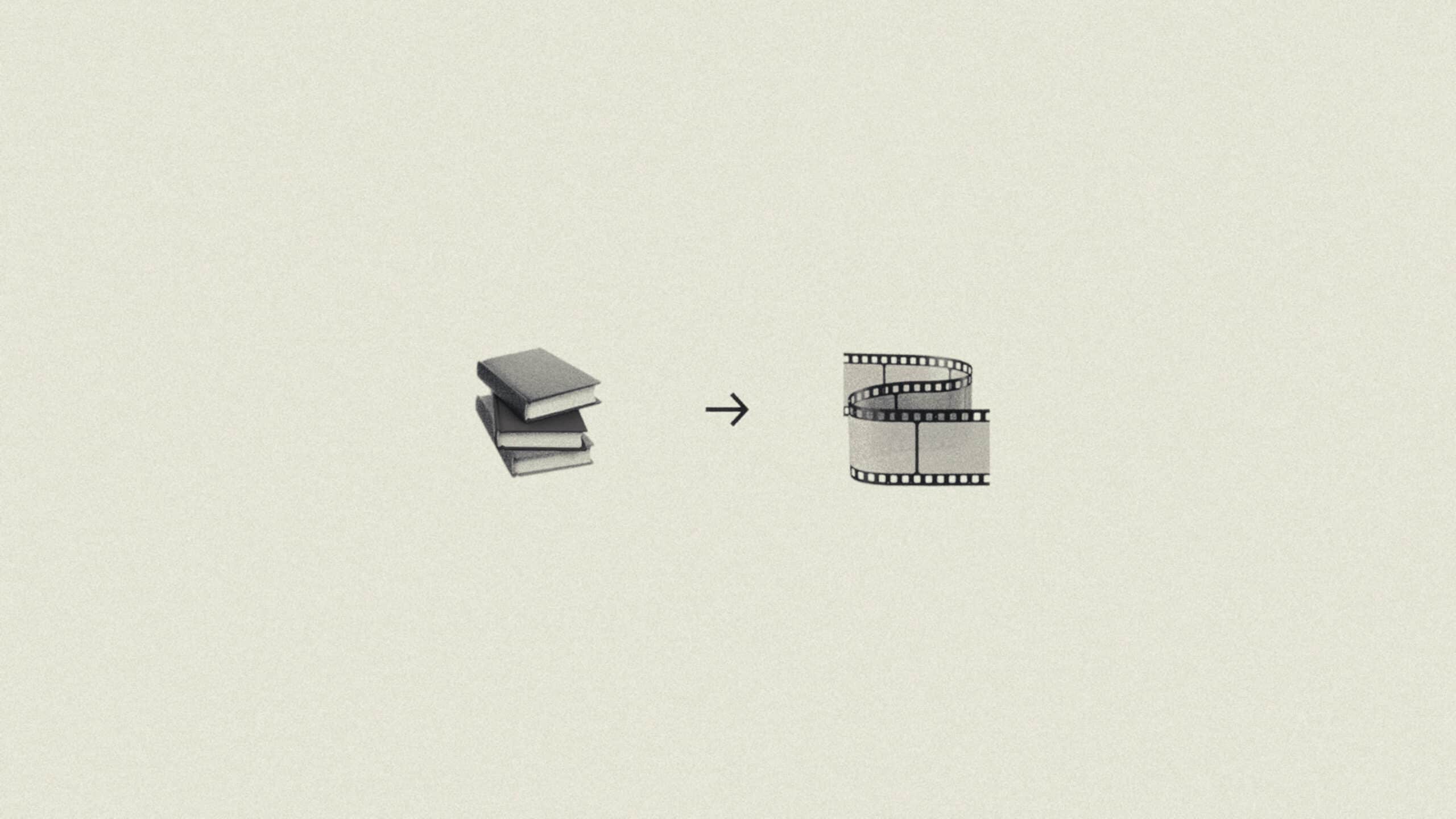
from text to screen. part I.
A study of how books metamorphosize to movies and the underhanded contextual changes.
When I read a paper called The novel path to cinema in the Sunday Tribune more than a decade ago, I was intrigued to say the least. The piece by Shoma A. Chatterji examines the unique relationship between literature and cinema. She asks the question, ‘Can the screen version stray from the original and adapt itself for celluloid?’
Shoma Chatterji makes a note of some of the most brilliant adaptations made in Hindi cinema- like Sanjay Leela Bhansali’s Devdas, Vishal Bharadwaj’s Omkara, Bimal Roy’s Sujata, Guru Dutt’s Sahib, Bibi aur Ghulam, Vijay Anand’s Guide and Shyam Benegal’s Sooraj Ka Satvan Ghoda. The write up favors the eclectic form of art over literature. The writer opines that celluloid adaptation offers the filmmaker a challenge to pick the writer’s work and through this transposition, make it as powerful and appealing on film as it is in its printed form. It offers infinite scope for argument, discussion, debate and questioning among spectators who have read the novel.
The writer goes on to say that a piece of literature need not remain confined to celluloid ‘translation’ of an original piece of written work. It is for the filmmaker to judge and decide on whether a particular piece of literary work (fiction, non-fiction, drama, poetry) in any genre or language or form, that inspires his creative energies should be a translation of the original work, an interpretation, a critique, a comment or a question.
Cinema expresses the private vision of the filmmaker, be it in accurate imitation, political propaganda or visual abstraction – and the critical emphasis should be on the work of art – the film – itself and not on its comparison with the literature it springs from. The film is a larger piece of work than a novel because a film uses the technological tools to bring the story alive on screen to create a living ambience through sound, light, actors, music, editing, dialogue, production design, costume, etc. On the other hand, it limits the scope of the viewer/spectator to exercise his imaginative and creative powers that literature offers its reader. A film adaptation, at its very best, is by no means a lesser work of art than its literary source.
In such light, let’s look at vintage bollywood cinema’s classic masterpiece – Masoom – in relation to its literary half-brother (pun intended) – Man, Woman and Child by Eric Segal.
The acceptance of infidelity will always be situational, now in the year 2023 and back in the day – year 1983. Masoom’s amplification of the same, however, finds itself way ahead of its time. The idea of the film and the book was never to glorify infidelity, but to tell a story of when things happen – and they do. This will be interesting not only because of the plot, but also because of the fact that a ‘western’ set-up was adapted into a traditional Indian one, that too in the 1900s.
Let’s delve into the nuptials of this film’s making, while romancing the book it was inspired by (pun intended) and compare how much it changed while crossing borders.
the basic story:
The summary of the story from the book is that a happily married couple, Robert and Sheila, share two lovely daughters. But Robert had a secret. He had a one night stand with a french girl whilst on a conference. He didn’t tell his wife the same until, as fate would have it, the child born as a result of the affair came knocking on his door when his mother passed on. The boy, Jean Claud, was invited to stay with the family despite Shila’s initial hesitation, because he is afterall a child and nothing was his fault – Sheila was logical enough to see that. As they tested the waters with this new arrangement, the secret is revealed by a close family friend and all the family dynamics are set into a hurricane. When Jean-Claude falls ill because of his already fragile world falling apart, the family realizes that they have come to love him and he feels like their own. Sheila forgives her husband; and as for Jean-Claude, he discovers his fiercely independent side, and decides to go study in France, leaving the family of four behind.
The movie’s plot was somewhat similar. A modern Delhi couple – Indu and DK – live a blissful family life with their two daughters. However, DK hides a secret affair he had with a girl (Bhavana) while on a visit to Nainital. He, of course, did not tell his wife who was about to give birth to their first child. Bhavana did not contact DK when she fell pregnant because she was aware that he was married and she did not want to come in the way. When she passed, masterji sent nine year old Rahil, son of DK and Bhavana, to his home. Their whole world flipped. Rahul, however, had no clue about DK’s relationship to him. Indu wanted the child to be sent immediately but accepted the request of DK to give him some time to make arrangements. In the meantime, Rahul’s innocence and want for love set Indu’s emotions to turmoil.
DK arranged for Rahul to be sent to a hostel at Nainital to which he reluctantly agreed. But then he found out that DK is actually his father and ran away from home not really knowing what to do with his exploding emotions. When the police returned the boy, the family breathed in respite because they had developed a genuine concern for the child over the time he was with them. When the time came to send off Rahul to study at the boarding school, Indu gave in to her feelings of love and affection towards the child and brought him back from a boarded train to Nainital. DK is elated and grateful for his wife’s acceptance and they drive home to live happily ever after.
There were many things that were followed through in the movie and were in tandem with the book. – from the family set up (husband-wife, two daughters) to the gender of the illegitimate child. What shone through as major differences were the nature of the child and the endings of each.
personality traits of the protagonist:
Jean-Claude was an independent, mostly likable child that knew the ways of the world. In Masoom, as the title suggests, the boy – Rahul – has an air of innocence and mystery surrounding him throughout the film. He came with a strong need for love, attention and direction from a mother and a father – and wins people’s hearts because of his almost naive sweetness. Rahul was easy to fall in love with with his deep green melancholic eyes, nonchalant mannerisms and overall innocence – some respite that was almost essential for the average Indian spectator to be nudged into acceptance of the otherwise twisted ordeal of infidelity.
The film didn’t take a bold turn to show the boy to be difficult or maybe even acting out because he is hurt or in grief because he lost his only parent and his whole world changed in a flash – which would be a more realistic cinema and something maybe today’s age would have gladly explored. The film certainly shies away from complex emotions and instead banks on the cuteness of this child carrying an otherwise controversial narrative. Was it still great cinema to watch? Absolutely! The directorial debut of Shekhar Kapoor was and is a success because of its smooth progression, an honest belief in the characters and a deep portrayal of the story. Its nativeness makes it a timeless classic for Indian cinema.
the endings:
Both endings were ‘good’ as they provided closure and a satisfied ability to remove oneself from being surrounded by the story, but they were very different and clearly showed a distinction between two cultures and what drives them.
The book ends with Jean-Claude venturing out to find his own path after being acquainted by the truth of his being. His story was all about knowing the things that were hidden from him, finding the missing pieces of his life, coming face to face with his father who was married to someone other than his mother, his crumbling upon such a consuming situation and his resurrection with new confidence. This fierce independence is what parents of the west aspire for their children.
The movie ends with Indu graciously forgiving her husband, despite his lack of character, very much keeping up with the theme (and plight) of Indian women who often forgive way more than they should. Indu had to succumb to her maternal instincts and along with that came forgiveness for her husband. And they all drive back happily as a family.
I feel that Shekhar Kapoor deliberately chose this ending so as to make it more palatable to his Indian audience because having shown infidelity was pushing the boundaries enough, let alone to send off a poster-child. The bottom line, this ending didn’t have much room for introspection. The choices were obvious and almost blatant.
In retrospect, both the book and the movie were unique in their own ways and catered well to its own audiences. All you need is a good original story, it doesn’t really matter where it comes from. A strong innate sense of knowing who your consumer is will always be your guiding light.
The age old battle of book vs. movie can actually come to a rest if one understands that both are unique to their purpose. A book tells a story and allows you to give body and shape to the written word. It thrives on how deep you can go into your subconscious and make the story yours. Films, however, are more deliberate. The director not only directs the story, they also direct your eye, your vision exactly to what they want you to see. They show you the story how they perceive it – and feelings simply follow suit.
Do you have a story to tell through film? Get in touch with us, we love a good story (and a good book).
share



